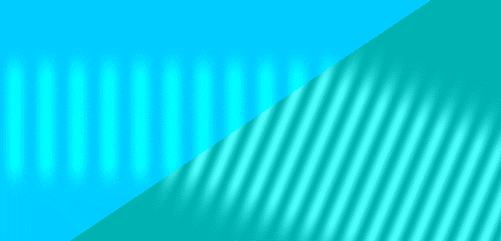Refraction in Prisms and the Rainbow
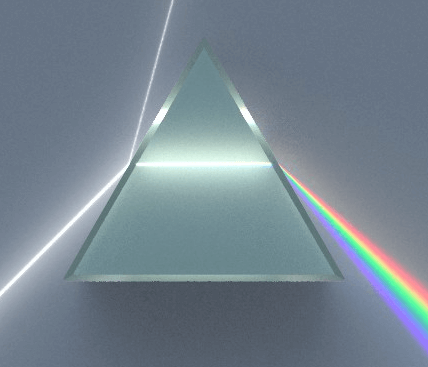
Refraction

Before rainbows we must begin with a very important physics concept, refraction. Refraction describes the change in direction of a light path when it passes into a different material. Light passing from air into glass, water, clear plastic, etc experiences refraction. Light passing through a prism experiences refraction both when it enters and exits, which allows it to split white light into its colored components.
While all wavelengths of light move at c = 2.998*108 m/s in a vacuum where there is no air, they travel slightly slower in matter (including the gasses that form air). This is because each atom will absorb the light energy, and then reemit the energy into the next atom in the light's path. Although a near instant process, it does slightly delay the speed of light. Dispersion of Light by Prisms

So light is slightly slowed by air molecules, and it is slowed even more by materials like water, glass, and plastic. This change in speed will cause refraction, the bending of the light path. Going from a "slow" material like glass into a "fast" material like air will also cause refraction. We used the term index of refraction to define how "slow" or "fast" a material is. Light travels slow through materials with high refractive indices, and light travels fast through materials with low refractive indices. For example, a vacuum where there is no matter and light travels the fastest, has a refractive index of 1. Air has a refractive index of ~1.0003. Water has a refractive index of ~1.333. Note that refractive indices for a material are dependant on the wavelength of light as well as temperature and pressure to a lesser degree.
| Refractive Indices | |
|---|---|
| Vacuum | 1 |
| Air | 1.0003 |
| Water | 1.333 |
| Glass | 1.5 |
| Lead Glass | 1.7 |
| Cubic Zirconia | 2.15 |
| Diamond | 2.42 |
| Rutile | 2.61 |
Diamonds were highly sought after because of their rainbow sparkle (refered to as "fire") which occurs because they have a high refractive index (meaning light travels through them slower and bends more). Diamond is very dense, which typically corresponds to a higher refractive index.
So why does the direction of light change when it passes into a "slower" or "faster" material? It all boils down to the fact that light travels in waves.
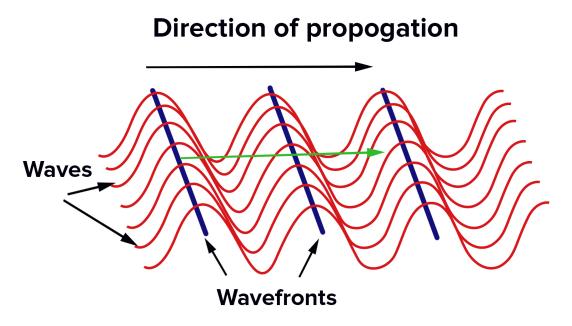
In a beam of light there are countless photons traveling in waves. These waves line up with each other so that the peaks next to each other form a wavefront.
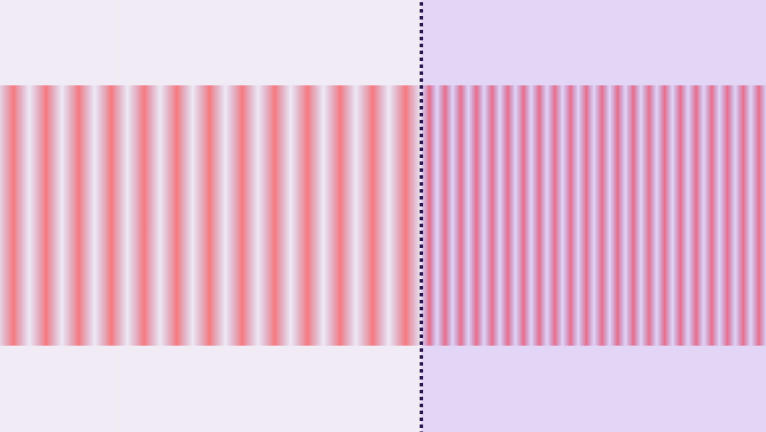
Here the wavefronts are represented as colored lines. The spaces between these lines are the waves' valleys. The waves are traveling fast until they pass into the new material where they start traveling slower, represented by condensed wavefronts. When light passes through a surface at 90 degrees, it does not change direction, it easily slows down (or speeds up) in the new material without complication. However something happens when light hits a surface at an angle.
Note about wavelength in the diagrams and its affect on color
The differece in length between the wavefronts represents both a change in speed and wavelength. I have equated color and wavelength under the assumption that we are seeing the wavelengths in a constant material, air. Considering the wavelength changes upon change in material, does that mean the color changes? I don't know for certain, but we don't see this as a change in color, because all light passes through the fluid "vitreous humor" in our eyes before we see it; said fluid has a fixed refractive index of its own which makes the material light passes through before our eyes irrelevant. If red light passes from air to our eyes, or from water to our eyes, we will se it as the same color. Maybe if we could change the fluid in our eyes to one with a different refractive index, we could see if this change in wavelength affects how we see color, or if it is really light's frequency/energy that determines the color we see light as.
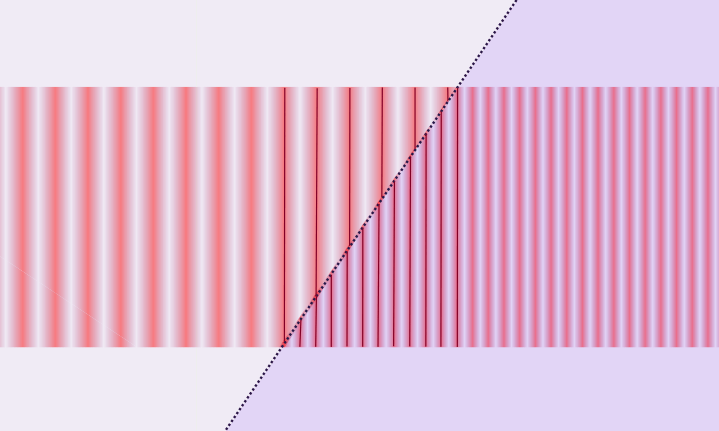
If the light went straight through the new angled material, we would get broken up peaks and valleys shown here. Notice how many more peaks are touching the surace on the right side, where as the left side only has a few peaks touching the surface, they are not lined up either. This is not possible though. As the peak of a light wave passes into a new material, it does not suddenly become a valley or inbetween, it has to continue in the wave pattern.
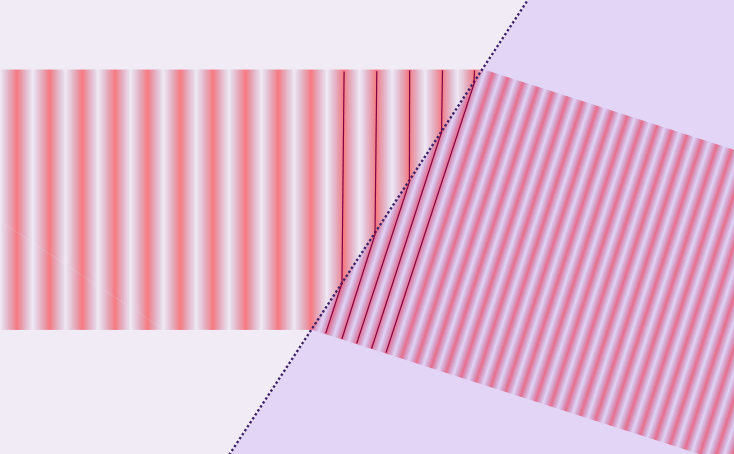
The only way for the waves' peaks and valleys to stay intact as they pass into a different material, is for the light path to bend. Notice how there are the same amount of peaks and valleys touching the surface on both sides, despite their difference in speed. They also line up with each other, meaning the light waves were able to follow the wave pattern. See below for an animated illustration.
The more angled the surface is to the path of light, the more the light will bend when entering/exiting it.

Which direction the light bends, depends on whether it is going into a "slower" or "faster" material.

To describe the change in direction we reference "the normal" which is just a line perpendicular to the surface of the material. When light travels into a "slower" material, it bends towards the normal. Conversely, when light travels into a "faster" material, it bends away from the normal.
So why are certain materials "slower" or "faster" than one another? Often more dense materials are "slower", but that is not always the case. To be more accurate, it is related to the amount of energy required to put the chemical structure of the material at a higher energy state than its resting stateDispersion of Light by Prisms This is a very precise unit of energy, unique to an atom, molecule, crystal, or other structure. In order to put a molecule into a higher energy state, the energy it recieves must be exactly equal to the difference between its current state and excited state, it cannot be less or greater than that.Quantum Energy Levels in Atoms - LibreText Chemistry The closer the energy of light is to the energy required to "excite" the material, the slower it moves through said material.Dispersion of Light by Prisms Note that the light passing through the material rarely has enough energy to actually put the material into a higher energy state, its just how close it is that determines the speed.
Since mass density does not always correspond to how fast light travels through a material, the term optical density is used instead. Light travels slowly through materials with high optical density, and travels quickly through materials with low optical density. The index of refraction is a unitless measurement used to quantify optical density, with empty space used as the reference point. Optical Density and Light Speed
Prisms and Dispersion
Not only do different materials have different excitation energies, but different wavelengths of light also have different amounts of energy (The Visible Spectrum). The closer the energy of a specific wavelength of light is to the energy required to excite the material, the slower the color of light will move through said material. The further way the light energy is to the material's excitation energy, the faster it moves through the material.Dispersion of Light by Prisms Since these materials almost always have higher excitation energies than light, and violet has the highest energy of all the visible wavelengths, violet is always slowed and bent more than the other colors (regardless if the light is traveling into a "slower" or "faster" material). Likewise, red with the lowest energy, is slowed and bent the least.
Because different wavelengths of light move at different speeds in the same material (and thus get bent at different angles), white light passing through a prism will split into all the different wavelengths that make it up, which is called dispersion. The slightly different directions these wavelegths go separates them, allowing the individual colors to be seen rather than just white light.
Rare reverse dispersion
On very rare occasion there are materials that have excitation energies lower than the energy of wavelengths in the visible spectrum. Since red has the lowest energy, it will be closest to the said material's and be slowed down the most, resulting in abnormal dispersion, where red is bent the most and violet is bent the least by a change in material. Radiation - Britannica
Speculation: Theoretically this means that there are also materials that have an excitation energy in the middle of the visible light energy range. Suppose it was at a yellow wavelength, that particular wavelength would be absorbed (not visible), and then the yellows around it would be bent the most, then green and orange would be bent medium, with red and blue bent the least, causing an overlap in the colors that are equally bent (yellow, green + orange, red + blue), possibly creating a yellow to purple gradient instead of a rainbow. This is just speculation of mine however.
The shape of prisms
Most glass windows do not throw rainbows when direct sunlight passes through them, however many leaded glass windows will (at the right time of day). Notice how prisms are usually a triangular prism or pyramid.
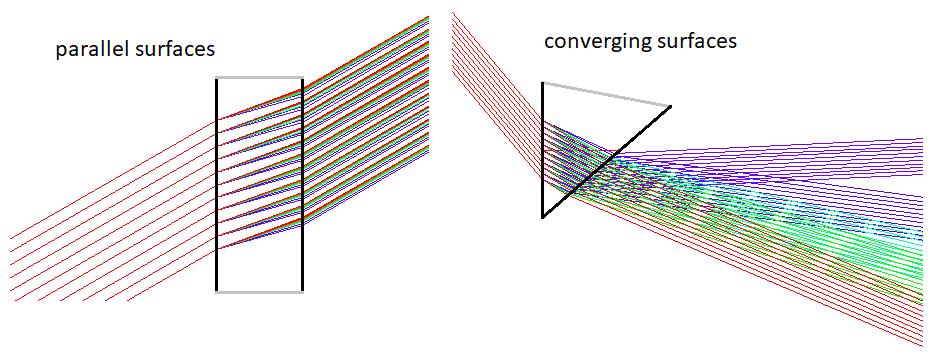 diagram slightly edited from BarsMonster on StackExchange
diagram slightly edited from BarsMonster on StackExchange
This is because a normal window has parallel surfaces that the light enters and exits. When the light exits the parallel glass surface, the lights refraction as it passes back into air is the reverse of that as it entered the glass, stopping the divergence, meaning the colors have only seperated for as long as they were in the relatively thin glass. In the diagram above, the parallel rainbows (through a parallel faced material) will overlap, creating white again, except at the very edges where a red-yellow edge may be observed on one side and a blue-violet edge on the other side. Because a pyramid or beveled edge does not have parallel surfaces, the light upon exiting the glass will be additionally refracted, separating the colors further so that they don't overlap as much. Why doesn’t a normal window produce an apparent rainbow? Although a cube or rectangular prism also has parallel surfaces, if light enters one near an edge, so that it exits through a face that is not parallel to the one it entered, it can also produce a rainbow.
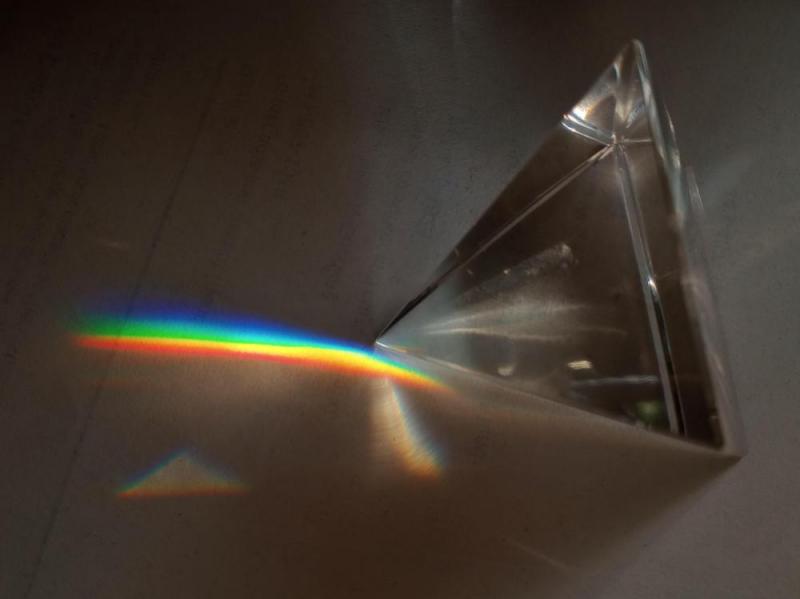
Here you can see a prism dispersing light into a rainbow, where the colors overlap closer to the prism.
Rainbows
So what do prisms have to do with the rainbows we see in the sky?
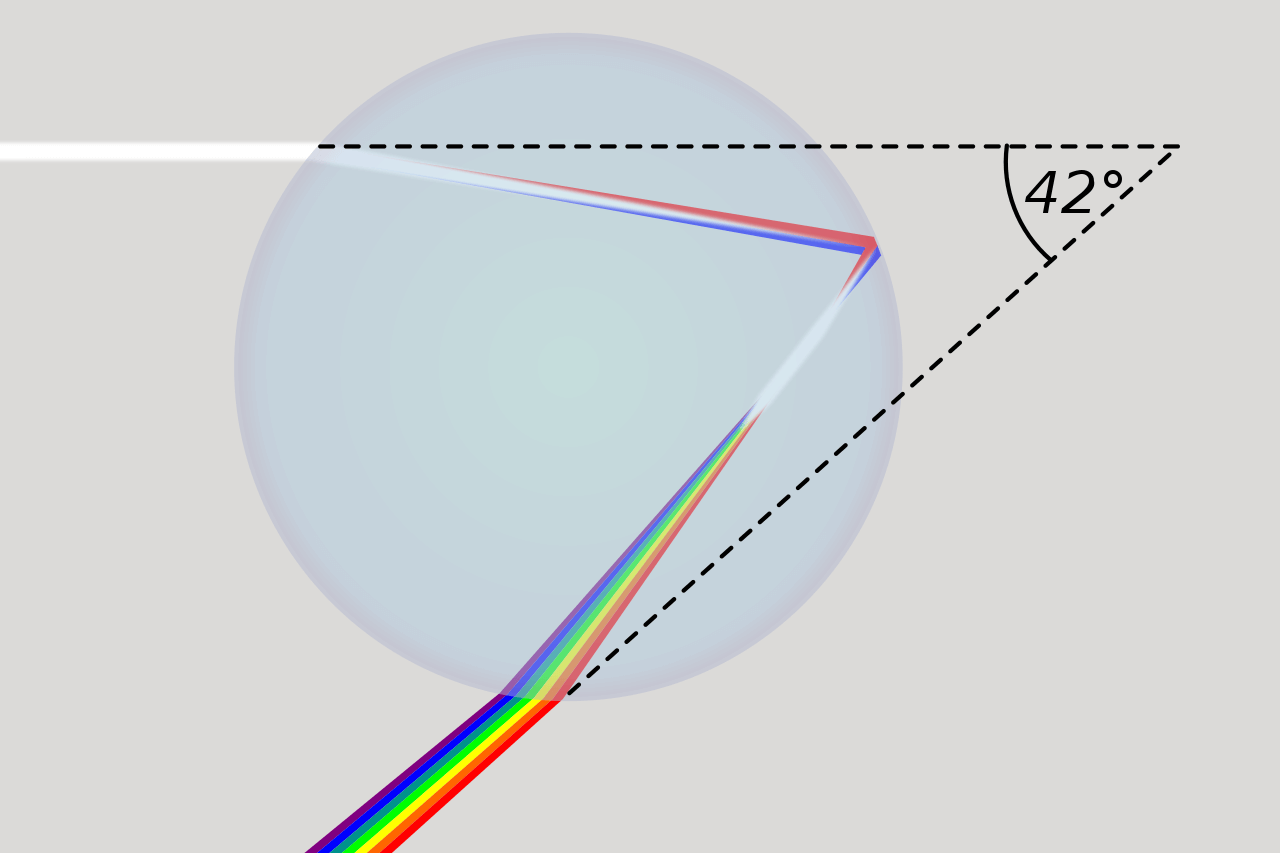
Basically, water droplets in the air act as prisms, splitting the white light from the sun into a spectrum of colors. Notice that the light is reflected by the inside of the water droplets. So the light enters the droplet, is reflected by the inside surface of the droplet, and then exits the droplet. Note that most of the light that enters the water drop passes right through it rather than reflecting, but this light does not form a rainbow, only those that are reflected within the drop do. This is explained on the next pages, primary rainbows and secondary rainbows.
Suggested next page: Primary Rainbows
